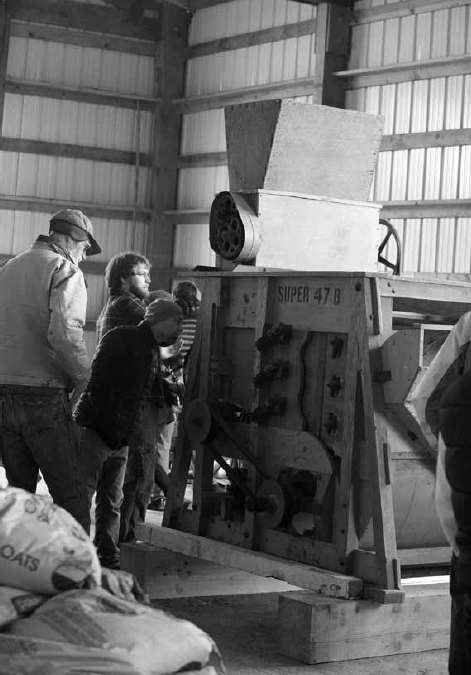When farmers lose buyers, whether a farmers’ market customer, local processing facility, or grain mill, it becomes that much more difficult to make a living by farming. Our region’s farmers reflected this reality in 2017 when they identified gaps in the food system infrastructure such as food processing facilities, storage including dry refrigerated and frozen space, grain handling and milling capacity, and an aggregation point for distribution and collective marketing. Asked why these needs exist, farmers pointed to a need to expand or sustain high-value markets for agricultural products, and in some cases to create a market of any kind.

The history leading to this situation involves a combination of factors. These include development pressures, increases in the number of smaller farms competing for limited direct-to-consumer markets, consolidation and resultant stagnation of wholesale markets, ebbs and flows of foreign purchasing and production, competition from more expansive agricultural regions, and processing infrastructure that has followed production to these regions.
It is also difficult to make absolute claims when working to address this problem. How badly do farmers need market support? What infrastructure if any is needed? Will it be profitable? If it is available, will it be used? Who showed up to the meeting to say so?
As a result, no single effort (infrastructure or otherwise) is likely to be a panacea for farm profitability. Nevertheless, a few regional collaborations are paving the way (or rather, opening the furrows) for a variety of agricultural infrastructure projects that could create important market opportunities for the region’s growers.
Shifts in farmland acreage and water rights
Understanding regional farmland loss is critical to building support for substantive investment in agriculture and market development. Looking at farmland acreage and water rights over the last several decades shows that large acreages are being lost while small acreages are buoying new smaller-scale operations. The region is never likely to lose diversified small farms serving urban and peri-urban markets, but large and continuous expanses of farmland, many with long-held water rights that are attractive to developers, face a very uncertain future.
In Thurston and Lewis Counties, farm acreage has diminished substantially since the 1950s. The 2012 Census of Agriculture reported 76,000 and 132,839 acres of farmland in Thurston and Lewis Counties respectively. Compare this to the 1950 county agriculture census with acreage well over double the current amounts:
170,640 acres in Thurston and 304,253 in Lewis. Taking a more recent span, farm acreage since 1978 decreased modestly in Lewis but increased modestly in Thurston County.
Looking deeper, from 1978 to 2012, average farm size decreased from roughly 110 to 70 acres (averaging across both counties) while the number of farms increased from 618 to 1,336 in Thurston Co, and from 1,136 to 1,647 in Lewis Co. Evidently, small farms have proliferated, as over half of these farms gross under $2,500 per year, and 93 percent qualify as “small” according to the USDA (gross sales under $50 thousand).
An examination of recent water rights transfers reveals the troubling fact that most have been between long-time agricultural family holdings and well-known developers, according to Thurston County.
What happens when infrastructure disappears
The role of infrastructure in farm viability and farmland loss dynamics comes clear when infrastructure disappears. In 2018, the last vegetable processing facility (operating out of Chehalis, WA) stopped buying crops from farmers in the region. That was National Frozen Foods, and it eliminated a market for approximately one to two thousand acres of vegetables ,mostly in Lewis and Grays Harbor Counties.
The loss of processing crops, combined with low milk prices that effectively eliminated a market for feed crops recently, has some farmers in the region focused on a basic but difficult question: ‘What next?’
To get a local perspective, I spoke with Brian Thompson, a long-time farmer in the region, about crop production trends and agriculture infrastructure. He was not sanguine about the health of the farming industry. He had witnessed a good portion of the loss of 270,000 acres of farmland in Thurston and Lewis Counties since 1950, with a parallel loss of grain markets, grain mills and other processing facilities. Thompson noted that crop production is dominated by hay and forage which he said was about the only remaining large-scale reliable crop, given low grain prices and no vegetable-processing buyers.
A new large-scale grain-handling facility?
Thompson is among several farmers in Lewis and Grays Harbor Counties, including Jay Gordon and Dave Fenn, who have enlisted the Northeast Ag Business Center, WSU Extension, Economic Development Councils in Thurston and Lewis Counties, and the Ports of Chehalis and Olympia, to evaluate the opportunity for a large-scale grain handling facility at the Port of Chehalis. The effort recently garnered support from Distressed Counties Funds from Lewis County, but was not included in the latest capital budget request to the state legislature. The facility, if built, could serve local specialty markets such as craft malting, brewing and distilling, serve larger feed markets North and a large-scale malting market out of Vancouver, WA, and provide organic and conventional grains for dairies.
Or value-added fruits and vegetable processing?
Complimenting grain market development, another infrastructure effort that has received attention in the last year involves a group of farmers working with several organizations, including the South Sound Food System Network, Olympia Farmers Market, Enterprise for Equity, and WSU Extension.
This group conducted several market assessments in 2018 to evaluate market potential for organic, value-added frozen vegetables and fruit. The team found, among other results, that shoppers at the Olympia Farmers’ market were interested in purchasing locally processed frozen vegetable and fruit products, with most (47 percent) motivated to buy local in order to support the economic viability of local farmers.
Other parts of the market assessment effort looked at the potential for institutional sales of locally grown and processed vegetables (such as to hospitals, schools and correctional facilities), and sales through vegetable-box subscription programs. Contacts at state cafeterias (such as the Department of Ecology), oddly, proved difficult to cultivate despite what would seem to be thousands of employees willing to support the region’s farmers.
Successful models in other states
A frozen processing facility, if built, would emulate successful efforts in other regions of the country, such as the Franklin County Community Development Corporation operating out of Greenfield, MA, Farm Bridge operating out of Kingston, NY, and the Mission Mountain Enterprise Food Center operating out of Ronan, MT. Each of these facilities aggregates fresh product from farmers, maintains numerous market accounts that are often too big for any one farm, adds value through processing, and in some instances processes for farmers to sell back through their own high-value market channels.
Another infrastructure effort of regional interest in Southwest Washington is an agricultural business park envisioned for Tenino, WA. This effort, led by the Thurston Economic Development Council, has received funding from a variety of sources for master planning, including the state legislative capital budget, and the United States Department of Agriculture Rural Development Program, among others. This facility is envisioned for established businesses, such as food processors and manufacturers, who could provide a market for farmers.
The benefit of coalitions and partnerships
Whatever the infrastructure initiative, regional partnerships among multiple organizations, operating in one or several counties, and involving a combination of agriculture and economic development partners may be the best strategy to yield market opportunities.
Indeed, examples from elsewhere are proving this. A coalition of partners working in Skagit County over recent years assisted the development of a new craft malting operation (Skagit Valley Malting), a craft milling enterprise (Cairnspring Mill), an educational program (Skagit Valley Brewing Academy run by Skagit Valley College), and an internationally-known grain-based research initiative (The Bread Lab run by Washington State University).
This partnership effectively provided potato and other crop growers with critical rotation crops, in this case wheat, barley and other grains. Involvement from the Port of Skagit provided seed financing and attracted private capital. And farmers have benefited on the one hand from markets for malting barley and milling grains, while on the other hand the increased public awareness that generates additional marketing opportunities.
A new coalition in SW Washington holds promise for a vigorous regional food system
Taking a page from this team-building playbook, a broad-based coalition recently took root in southwest Washington. Three partners including the Port of Chehalis, Thurston EDC, and WSU Thurston County Extension initiated a regional letter of understanding, with the aim to increase cooperation and develop a strategic vision for regional investment in agricultural infrastructure. Such an effort could improve funding opportunities at the state or in other funding initiatives, while creating a sense of buy-in and taking advantage of complimentary needs.
To date, twenty-one regional organizations and jurisdictions have signed on to the letter of intent to collaborate on infrastructure investment. Signatories include two county governments, two Ports, two cities, two regional colleges, the Washington State Dairy Federation and several other partners. Going forward, the success of regional infrastructure development work is yet to be seen.
However, a broad-based coalition is unlikely to be deterred by inevitable set-backs and missed funding opportunities, such as the capital budget request for the grain facility. After all, the need will not disappear.
What’s more, saving farmland and creating jobs is of more than academic interest to communities throughout Southwestern Washington. For many, these are neighbors, friends, employers, and community leaders. And in an era of increased interest in food access, nutrition and food security, the environment is conducive for building support for vigorous regional food systems.
Stephen Bramwell is the WSU Thurston County Extension Director.

Be First to Comment